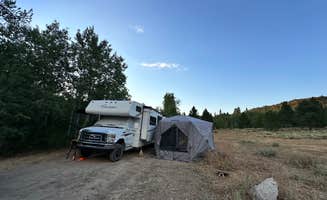Tent camping near Castleford, Idaho provides access to the South Hills region where elevation ranges from 4,500 to 7,000 feet, creating distinct temperature zones throughout the camping season. Most campgrounds in this region operate seasonally from late spring through fall, with accessibility often limited by snow conditions in higher elevations. Access roads to many sites are unpaved and can deteriorate after rain or during early season snowmelt.
What to do
Creek exploration: Third Fork Campground connects directly to hiking trails where campers can enjoy walking paths along the creek. "This is a no frills campground located in the South Hills of Idaho about 20 miles south of Twin Falls. A bonus of staying at this campground is that you have walking access to the Third Fork Trailhead!" notes Alan B.
River activities: At Juniper Grove Campground, visitors can access creek pools during summer months. Beth M. reports, "Juniper Grove has four campsites and fire pits, a pit toilet, a lovely creek with accessible pools, tucked up against a rock wall."
Wildlife viewing: The varied terrain around Castleford supports diverse wildlife populations including deer, wild turkeys, and numerous bird species. Early mornings and evenings provide the best viewing opportunities when animals are most active.
What campers like
Temperature relief: The higher elevations of camping areas in the South Hills provide natural cooling during hot Idaho summers. Temperature differences between Twin Falls and higher campgrounds can reach 10-15 degrees.
Privacy between sites: Big Cottonwood Campground offers secluded spots with natural barriers. Chani K. describes one site: "It's right up against the river and has excellent privacy. There is a designated fire pit, perfect access to the beautiful flowing river, and is easy to drive in and out of."
Water features: Most tent sites in the region feature creek or river proximity, enhancing the camping experience. Beth M. noted about the Jarbidge area, "This whole area is absolutely lovely and extremely accessible. No cell signal anywhere near."
What you should know
Road conditions: Access to many campgrounds requires driving on rough dirt roads. Bear Gulch exemplifies this challenge with its remote location.
Communication limitations: Cell service is nonexistent at most campgrounds in the region. Beth M. confirms about Juniper Grove, "No water, no data access," and similarly reports about Big Cottonwood, "No cell signal anywhere near."
Water levels: River conditions can vary significantly by season and year. At Juniper Grove, Allison W. advises, "The river itself is beautiful and so much fun to raft, but this section is kind of spread out and shallow, making it essentially impossible to float on. I'd recommend calling ahead to ask them about the situation on the river."
Tips for camping with families
Activity preparation: Pack materials for non-water activities since water levels can be unpredictable. Simple games, field guides for plant identification, and star charts are practical options when creek activities aren't viable.
Site selection: Choose campgrounds with bathroom facilities if camping with younger children. Michael G. notes about Big Cottonwood Campground, "Vault toilet pretty gross as usual," so bringing sanitizing supplies is advisable.
Temperature planning: Pack clothing for significant temperature swings, especially at higher elevations where days can be warm but nights cool rapidly. Overnight temperatures can drop below 50°F even in summer months.
Tips from RVers
Vehicle stabilization: Secure loose items before traveling rough roads to campgrounds. Amanda M. cautions about the drive to Bear Gulch, "Secure what you can as your stuff will vibrate everywhere. No problem fitting our 33" motorhome and extra vehicle."
Space assessment: Several campgrounds accommodate larger vehicles despite primitive conditions. At Bear Gulch, campers report suitable space for mid-size RVs plus additional vehicles, though advance research is essential as conditions change seasonally.
Limited services: RVers must arrive fully self-contained as no hookups or dumping facilities exist at these campgrounds. Bring ample fresh water, as water sources at campgrounds require treatment before consumption.


